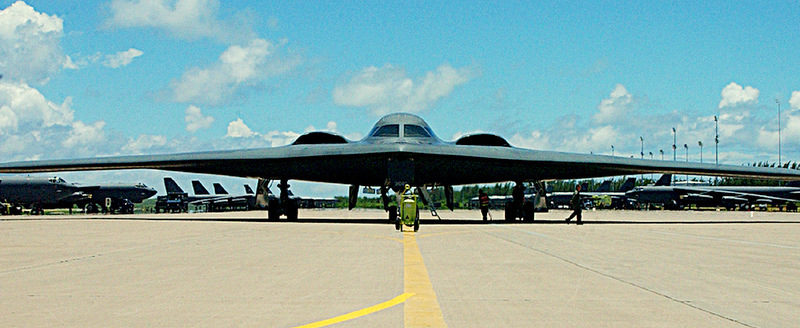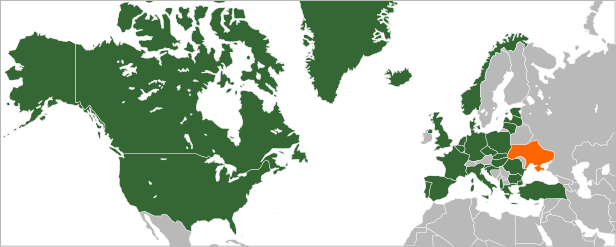
The United States and NATO are currently holding military exercises in the Russia-bordering nations in an attempt to alleviate tensions among Eastern European nations that have grown increasingly alarmed about Russia’s moves to restore a semblance of the hegemony it held during the Soviet era.
Russia’s recent actions — including seizing Crimea and encouraging Russian-backed separatists in eastern Ukraine — reflects on Russia’s 2008 war with Georgia and its occupation of South Ossetia and Abkhazia. Similar to the provocation of hostilities with Ukraine, the Georgia-Russia crisis was started by Georgia’s motions to join the West — namely, attempts for Georgia to receive a NATO Membership Action Plan.
In considering the West’s involvement in encouraging the Eastward expansion of NATO and considering the Russian perception that a NATO incursion on Russia’s borders presents a national security threat, it seems strange that NATO and the U.S. would engage in military exercises in Ukraine and in the Baltic states of Lithuania, Latvia, Poland and Estonia — a move that is likely to exacerbate problems.
Eastern Europe’s fears of Russian intervention were ratcheted up following Russian nuclear counterstrike drills, which concluded recently in Kazakhstan. The drills, which were announced last November, per Russian President Vladimir Putin, were meant to test the Russian national security readiness. The drills, which took place during a meeting of the heads of state for a post-Soviet security bloc, involved all branches of the Russian military in demonstrations of how anti-aircraft and aviation defenses, artillery and missile batteries can counter major missile or nuclear strikes, aviation sweeps or troops on the ground.
Though the close timing of the two tests is coincidental, the call for training in the European-facing former Soviet nations and the buildup of NATO personnel in these countries reflect a changing face of international politics in light of growing frustrations that economic sanctions and political isolation have failed to stop Russia’s perceived aggression against Ukraine.
Enlargement
At its core, the Ukraine situation is a question of enlargement. The European Union — and by extension, NATO and the U.S. — seeks to bring Ukraine and the rest of the Baltic states in alliance with the West as a means to both ensure access to trade resources the area provides and to bring the region under an economic model that would permit eventual trade integration into the EU. Ukraine is currently a priority of the European Neighborhood Policy — an EU foreign relations policy working to tie the bloc to its neighbors in Eastern Europe, the Middle East and Northern Africa.

Typically, joining the neighborhood requires an association agreement, which details an action plan or pathway for the potential member’s transformation toward adhering to the EU’s strict conditions for government, economic and social reform. In exchange for acceptable adherence to the action plan, the EU offers financial assistance and possibly tariff-free access to certain EU markets.
In practical terms, the process of establishing and enforcing an association agreement is akin to establishing the potential member as a client state to the EU. From a political and military standpoint, this could be interpreted as a forced withdrawal of the potential member from regional considerations to supranational or alliance considerations — something with the potential to create border tensions. With Ukraine controlling many of the pipelines that provide Europe with Russian gas, this could be problematic.
Russia, on the other hand, is also seeking to fortify its links to the Baltic states and Ukraine. As most of the former Soviet nations have well-defined trade and diplomatic relations, Russia’s position has been that anything that forces a radical shift in the region — such as a neighboring nation undergoing radical transformation in order to join the European Neighborhood — is a threat, both economically and politically. Russia also argues that the presence of ethnic Russians in lands bordering Russia suggests a regional link that would otherwise be corrupted or ignored if the nation’s focus shifts from regional to supranational.
“Ukraine and Georgia’s NATO aspirations not only touch a raw nerve in Russia, they engender serious concerns about the consequences for stability in the region,” wrote William Burns, then-U.S. ambassador to Russia and the current U.S. deputy secretary of state, in a 2008 cable released by Wikileaks. “Not only does Russia perceive encirclement, and efforts to undermine Russia’s influence in the region, but it also fears unpredictable and uncontrolled consequences which would seriously affect Russian security interests.
“Experts tell us that Russia is particularly worried that the strong divisions in Ukraine over NATO membership, with much of the ethnic-Russian community against membership, could lead to a major split, involving violence or at worst, civil war. In that eventuality, Russia would have to decide whether to intervene; a decision Russia does not want to have to face.”
While it publicly focuses on the fate of ethnic Russians in Ukraine, Russia’s interest in the country is actually more concerned with trade and military interests. Crimea hosted Russia’s only Black Sea seaport and, until former Ukrainian President Viktor Yanukovych was overthrown, Russia had sought to bring Ukraine into the Eurasian Economic Community as a first step in forming the Eurasian Union — a proposed economic union of Belarus, Kazakhstan, Russia, Kyrgyzstan,Tajikistan and Armenia. (The U.S. is strongly opposed to such a union.)
A measured response
This situation has created a scenario that the U.S. and NATO are bound by treaty obligations to respond to, but would rather not, as a response could aggravate the situation and lead to a costly, unpopular war.
“Both the United States and NATO have been clear that neither is prepared to go to war with Russia over Ukraine,” said Steven Pifer, senior fellow for foreign policy, the Center on the United States and Europe and the Center for 21st Century Security and Intelligence with the Brookings Foundation, to MintPress News. “However, there is concern — both here and in Europe — in that when Vladimir Putin used force to take Crimea from Ukraine in March, that really broke a fundamental rule of the post-World War II order in Europe, which is that big states shouldn’t use military force to take territory from small states.”
The use of military exercises afford the West the opportunity to be present militarily — at least in a symbolic fashion — in Ukraine and the Baltic states without creating the perception of a military build-up. The NATO/U.S. military exercises started in April, when small companies of American troops were deployed to Poland, Estonia, Latvia and Lithuania. According to Pentagon Press Secretary Rear Adm. John Kirby, these exercises are slated to last a month and will involve “real infantry training.”
“It’s a very tangible representation of our commitment to our security obligations in Europe, and the message is to the people of those countries and to the alliance that we do take it seriously,” Kirby said.
The exercises are components of a plan currently being developed to maintain a regular presence in Eastern Europe. Potential parts of this plan would be regular military exercises and a rotation of stationed troops. While most military exercises are posted to the Army Command website, details concerning funding levels for specific operations and exact manpower are classified and, therefore, open to change without public consideration.
Preparing for all possibilities
“I think we have to be alert to all possibilities,” U.S. Secretary of Defense Chuck Hagel said in a joint press conference with Polish Minister of National Defense Tomasz Siemoniak in April. “The actions of the Russians over the last two months is not only irresponsible and violates territorial integrity and sovereignty of a — of a sovereign nation, but it’s dangerously irresponsible.”
“[The] focus of collective security in — in particular NATO, or any region or nation is to anticipate and to protect themselves and think through what are the possibilities, what could happen? … We have to look at — based on past actions, we have to look at every possibility,” Hagel continued.
The commitment of a single company, however, pales to what Poland had requested: two combat brigades, each with as many as 5,000 soldiers. Poland currently finds itself in a particularly tricky situation — before the Ukraine crisis erupted, Poland was working to mend ties with Russia. With much of modern Polish history being defined by Soviet aggression, Russia’s actions in Ukraine stirred long-seated resentment and anxiety in Poland — a major agricultural producer and primary food grower for Europe.
Despite this, Poland is seemingly happy with the U.S. getting involved in this fight, regardless of the size of its commitment or the fact that the company consists of lightly-armed paratroopers.
“The United States is a superpower that has a very particular approach towards its troops presence abroad,” said Maj. Gen. Boguslaw Pacek, head of the National Defense University in Warsaw. “Even one American soldier means readiness to defend the area protected by this one soldier. We do not expect large numbers of troops but that is just the first step.”
Small gestures
The U.S./NATO exercises in Poland and in the Baltic states represent a longstanding series of exercises — most of which were established in 2012. Exercise Saber Strike, for example, is an annual training exercise involving 14 countries and focused on Lithuania, Latvia and Estonia. Finland, France, the United Kingdom, Poland, NATO, U.S. Air Forces in Europe (USAFE), the U.S. Army and the Air National Guard and the U.S. Army Cadet Command all participate. Other exercises include Exercise Rapid Trident in Ukraine, Exercise Saber Guardian in Romania and Exercise Shared Horizons in Georgia.
These exercises all reflect a conflicted argument. In Germany, a multinational exercise — the Joint Air Warfare Tactical Exercise, or JAWTEX 2014 — is currently underway to test the tactical integration of Germany’s forces with EU and American forces. In the Philippines, Filipino and American forces are involved in war simulations despite growing tensions over maritime rights with China.
Yet, with such a marginal representation of force actually being permanently stationed with Russia’s neighbors, it’s worth asking whether the U.S. is willing to fight for Ukraine beyond economic and political sanctions. If the U.S. and the EU are unwilling to engage Russia in anything beyond the symbolic over Ukraine, this begs important questions on just how important Ukraine is to the West and whether Western intervention is helping or hurting the region.

